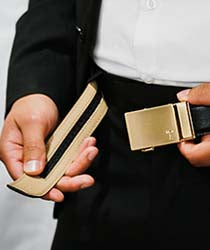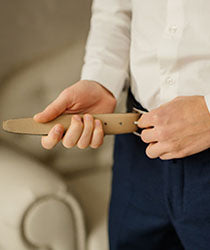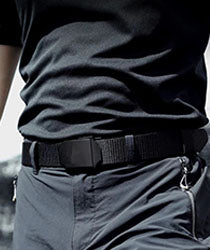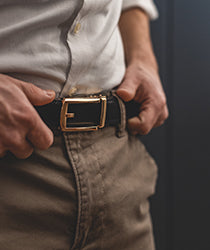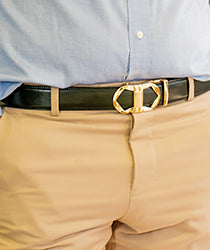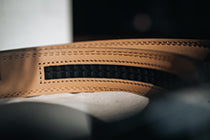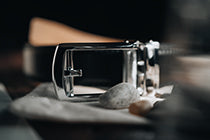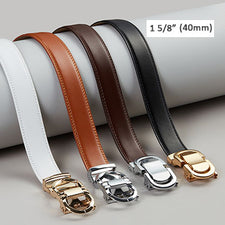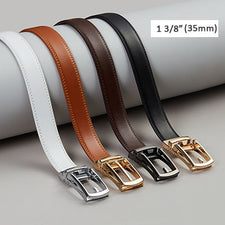Belts have been an essential accessory for men throughout history, transitioning from mere functional items to fashionable statements. Over the centuries, belts have not only served the practical purpose of holding up pants but have also become significant style elements. From the early days of basic leather straps to the current era of designer belts, the evolution of men's belts showcases the dynamic nature of fashion.
Introduction
Belts play a vital role in both functionality and fashion, serving as a means to secure pants and adding a touch of style to outfits. This article explores the rich history of men's belts, tracing their journey from their humble beginnings as purely functional items to becoming iconic fashion accessories.
Functionality of Belts
Belts have been used since ancient times to secure clothing and provide support. In early civilizations, such as the Romans and the Egyptians, belts made from leather or fabric were worn around the waist. These early belts served practical purposes, holding garments together and providing a convenient way to carry tools or weapons.
Throughout history, belts found their way into military and workwear. Soldiers in various armies wore belts as part of their uniforms, enabling them to attach equipment and keep their clothing secure during battle. Similarly, workers in different trades used belts to hold tools or provide back support during physically demanding tasks.
As time progressed, the materials used for belts evolved. Initially, leather was the primary choice due to its durability. However, with advancements in technology and access to different materials, belts started incorporating fabrics, metals, and synthetic materials.
Fashion Evolution
Belts began to transition into fashion accessories during different eras and within various cultures. In ancient Rome, belts denoted social status, with different materials and designs indicating wealth and importance. Similarly, during the Middle Ages, belts became a symbol of authority and were adorned with intricate metalwork and engravings.
Throughout history, influential fashion trends have shaped the way belts are worn. The Renaissance period saw the emergence of wide waist belts, cinching garments and accentuating the waistline. In the 20th century, the influence of celebrities and designers propelled belts into the world of high fashion, with iconic figures like Elvis Presley and James Dean popularizing the rebellious leather belt aesthetic.
Belts as a Style Statement
In contemporary times, belts serve as a style statement and offer a versatile way to enhance outfits. Whether it's adding a pop of color, introducing texture, or defining the waistline, belts have become an essential accessory for fashion-conscious individuals. The availability of various belt buckles, including those personalized or adorned with logos, allows individuals to express their individuality and make a fashion statement.
Designer and luxury belts have gained significant popularity, with renowned fashion houses incorporating belts into their collections. These belts often feature premium materials, unique designs, and impeccable craftsmanship, making them coveted items among fashion enthusiasts.
Contemporary Belt Styles
Today, men have a wide range of belt styles to choose from, depending on the occasion and personal preference. Casual belt styles, such as woven or braided belts, provide a relaxed and laid-back vibe, perfect for pairing with jeans or chinos. On the other hand, formal belt styles, like sleek leather belts, add a touch of sophistication to suits or dress pants.
The width of belts has also become an important consideration. Wide belts are often associated with a more rugged and casual look, while skinny belts are favored for their sleek and minimalist appearance. Belt trends continue to evolve, with new styles and designs regularly emerging to reflect the ever-changing fashion landscape.
Sustainability in Belts
In recent years, sustainability has become a key focus in the fashion industry, and belts are no exception. Many brands now prioritize eco-friendly materials and sustainable manufacturing practices when producing belts. Recycled or upcycled materials, such as repurposed leather or fabric, are used to create belts that reduce environmental impact. Additionally, ethical sourcing and manufacturing processes ensure fair treatment of workers and support responsible practices.
Future of Men's Belts
As fashion and technology progress, the future of men's belts holds exciting possibilities. Technological advancements may introduce innovative functionalities, such as belts with integrated smart devices or adjustable features for optimal comfort. Designers may continue to push boundaries, experimenting with unconventional materials, shapes, and patterns. The future of men's belts promises a fusion of style and functionality, providing individuals with ever-evolving options to express their personal fashion choices.
Conclusion
From their early days as functional items to their current status as fashionable accessories, the history of men's belts is a testament to the evolution of fashion. Belts have transitioned from practical tools to iconic elements of style, allowing individuals to enhance their outfits and make a statement. As fashion continues to evolve, the importance of belts in the realm of men's fashion remains steadfast.
FAQs
-
What are the most popular belt styles? Some popular belt styles include leather belts, woven belts, and fabric belts. The choice of style often depends on the occasion and personal preference.
-
How can I choose the right belt size? To choose the right belt size, it is recommended to measure your waist size and select a belt that corresponds to your measurement. Alternatively, you can refer to the belt size guidelines provided by the manufacturer.
-
Are belts only for holding up pants? While the primary function of belts is to hold up pants, they have also become a fashion accessory that adds style and complements outfits.
-
Can belts be worn with casual attire? Yes, belts can be worn with casual attire. They can add a finishing touch to jeans, shorts, or casual trousers, enhancing the overall look.
-
What are some eco-friendly belt brands? Some eco-friendly belt brands include those that prioritize sustainable materials and manufacturing practices, such as vegan leather brands, those using recycled materials, or brands with certifications indicating ethical and responsible production.

